greek art
1/314
There's no tags or description
Looks like no tags are added yet.
Name | Mastery | Learn | Test | Matching | Spaced |
|---|
No study sessions yet.
315 Terms
Classical Archaeology: Its Name and Significance
ἀρχαιολογία
ἀρχαῖος ( «ancient») + λόγος ( «discourse» , «study»)
Modern Archaeology
Historical science which studies human cultural activities through material remains. Scientific analysis of the past, aimed at reconstructing the past by examining material evidence in all their ambiguities. Context is essential for meaningful interpretation
Final goal: Historical reconstruction
Archaeological Evidence
Artifacts or monuments: Any human-made object, any remains (not only structures) communicating a message (neutral terms, avoids artistic judgment)
Archaeology
Broad, interdisciplinary field
History of Ancient Art
Specialized study. It is an essential part of Classical Archaeology that cannot be ignored. Collaboration between both disciplines enhances understanding of the past
pliny the elder
Roman author, naturalist, natural philosopher, and naval and army commander of the early Roman Empire, and a friend of the emperor Vespasian. He wrote the encyclopedic Naturalis Historia (Natural History) — more stuff but basically important guy
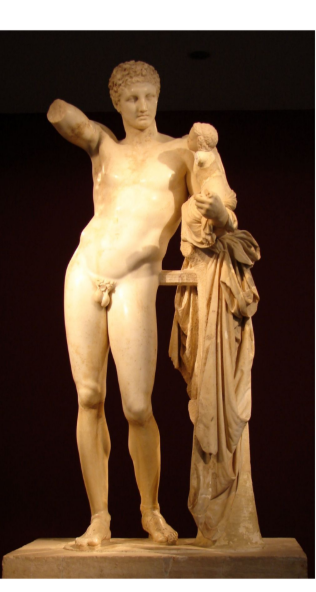
Pausania, Sanctuary of Olympia (Ἑλλάδος Περιήγησις, books 5-6)
Heraion. Hermes sculpted by Praxiteles
praxiteles
most renowned of the Attic sculptors of the 4th century BC. He was the first to sculpt the nude female form in a life-size statue. While no indubitably attributable sculpture by Praxiteles is extant, numerous copies of his works have survived; several authors, including Pliny the Elder, wrote of his works; and coins engraved with silhouettes of his various famous statuary types from the period still exist.
attic sculputors
basically those in the athenian (?) peninsula
apollo belvedere
The work has been dated to mid-way through the 2nd century A.D. and is considered to be a Roman copy of an original bronze statue created between 330 and 320 B.C. by the Greek sculptor Leochares.
Ideas Derived from Winckelmann’s Work That Influenced the Taste and Interpretation of Ancient Art for a Long Time
Biological Vision of Ancient Art
Art Ultimately Striving for the Perfection of the Human Figure, Pursuing an Idealized Beauty
OVERCOMING WINCKELMANN'S INFLUENCE
Artworks should not only be seen as monuments but
but as a document, firmly tied to the historical period
in which they were created.
• Not only aesthetic evaluation but analysis of
technique, stylistic and iconographic features
• Equal consideration of all artistic objects,
recognizing no hierarchy between major and minor
arts, and rejecting the ideas of "progress" and
"decline," giving all historical periods equal value.
Franz Wickhoff (1853-1909)
VIENNA SCHOOL!
3 main aspects that distinguished Roman art
from Greek art:
realistic portraiture,
spatial conception,
historical narration
Alois Riegl (1858-1905)
VIENNA SCHOOL
Analysis of everyday objects
absolute chronology vs relative chronology
Specific information derived from literary sources and inscriptions — vs — Contextualization through excavation, stylistic analysis, and typology.
Ernest Langlotz
crazy chronology thing he made idk (on slide its for Late Archaic art)
treasuries
lots of documentation on TREASURY OF THE SIPHNIANS AT DELPHI
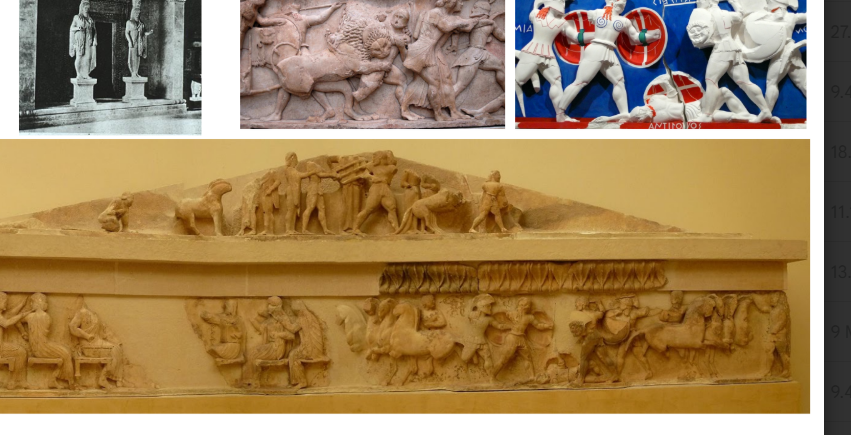
TREASURY OF THE SIPHNIANS AT DELPHI — Herodotus: 526-520 BC: build by the Siphnians using a tithe of the profits from its silver mines — HELPED DATE THE BEGINNING OF RED FIGURE PAINTING!!!!!!

Andokides Painter, 530- 525 BC Münich, Staatliche Antikensammlungen — BILINGUAL VASE
Andokides
ancient Athenian vase painter, active from approximately 530 to 515 BC.[1] His work is unsigned and his true name unknown. He was identified as a unique artistic personality through stylistic traits found in common among several paintings.
bilingual vase painting
vases painted with both black figure and red figure techniques
red figure painting
sometime around 525 BC. The evidence for this date lies in the connections between the Andokides Painter's work and a datable monument: the Siphnian Treasury at Delphi.
cicero had a similar opinion
to winkelmnn or whatever
THE PROTOGEOMETRIC AND GEOMETRIC PERIOD
refers to the early phases of Greek pottery where simple geometric shapes and patterns were used, spanning approximately from 1050 to 700 BC.
timeline in the protogeometric and geometric period
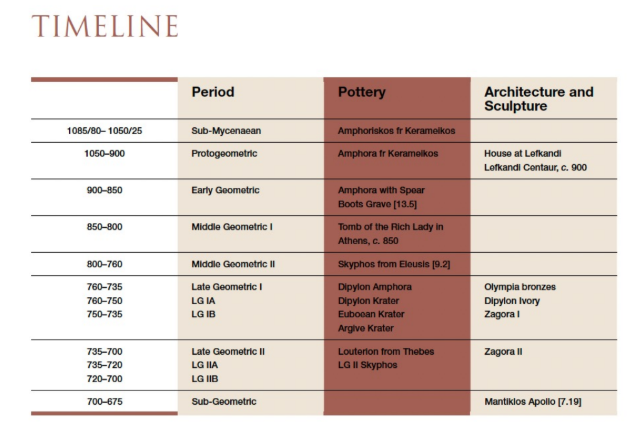
The Decline of Mycenaean Civilization
(13th – Mid-12th Centuries BCE)
what caused myceanean decline
•Key Changes:
• Collapse of the palatial system
• Loss of writing (Linear B script)
• Disappearance of monumental stone architecture and frescoes
•Possible Causes:
• A combination of factors, including:
• Natural disasters (earthquakes, droughts)
• Social unrest and uprisings
• Theories include the Dorian Invasion (debated)
Doric Invasion:
migration and colonization movement of the Peloponnesus by peoples of Doric origin, from districts in central-northern Greece.
pliny the younger ??? THERE’S TWO??????
was a Roman author and lawyer known for his letters that provide insight into Roman life, society, and the eruption of Mount Vesuvius.
Ionic Colonization
permanent settlement of Greek groups from mainland Greece along the western coast of Anatolia (IX-VIII
century BC). North to south (Anatolian coast): Eolid (people from from Thessaly and Boeotia); Ionic dodecapolis (peoples from
Attica and Eubea); Doric district (Doric people from the Peloponnesus)
Cultural Changes at the Transition Between the 2nd and 1st Millennium BCE:
•Shift from bronze to iron in weapon manufacturing
•Changes in burial practices (from inhumation to cremation)
•Emergence of the polis (city-state)
Attic Ceramic Production
Protogeometric style: 1050–900 BCE
• Early Geometric style: 900–850 BCE
• Middle Geometric style (MG): 850–760/50 BCE
• Late Geometric style (LG): 760/50–700 BCE

Nestor’s Cup from Pithekoussai (Ischia), late 8th century
BCE.
(From 775–750 BCE, it served as an emporion facilitating
trade towards northern Tyrrhenian regions.)
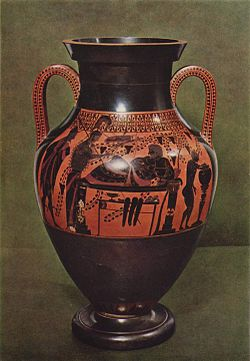
AMPHORA (for storage)
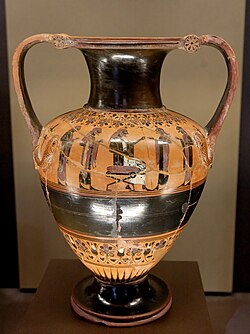
Nikosthenic amphora, c. 530 BC.
what is a Nikosthenic amphora
attic amphora especially for export to etruria

Lebes Gamikos - for weddings, c. 340 BC

krater (for mixing)
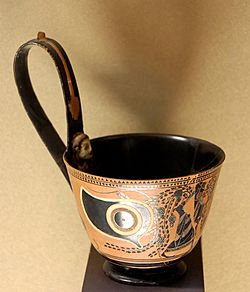
kyathos (for mixing)
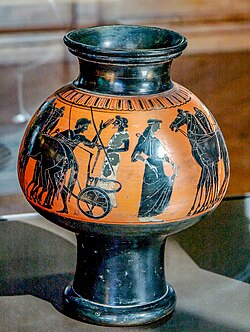
Psykter (for mixing)

Dinos (for mixing)
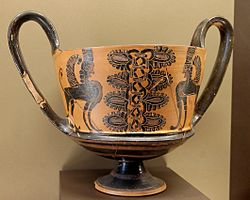
Kantharos type A
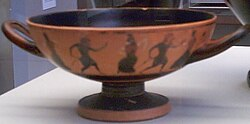
Kylix
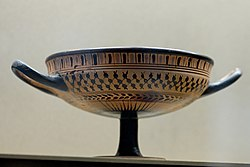
Kassel cup - specifically attic

Komast cup - a cup shape at the beginning of the development of Attic drinking cups.[1] Komast cups were widespread especially in Ionia and Corinth. Like other vase painters of the time, the Attic painters were under strong influence from Corinthian vase painting.
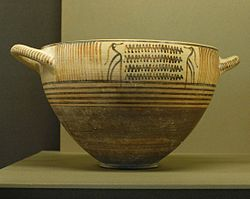
Skyphos, c. 740 BC

Oenochoe
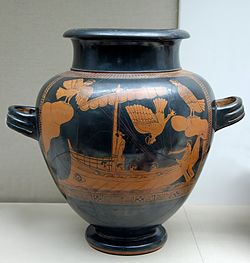
stamnos (storage)
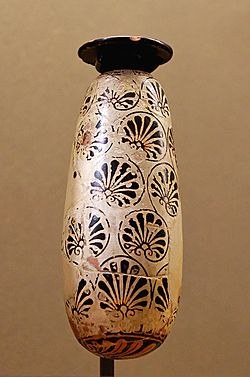
Alabastron, small holders for oil or perfume
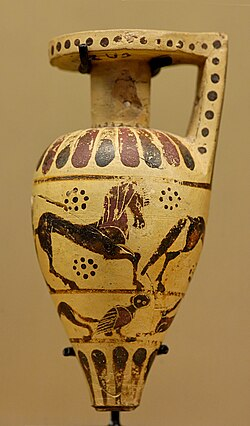
Aryballos
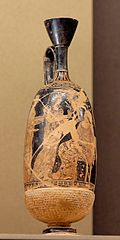
Acorn lekythos — lekythos are specifically used for storing oil
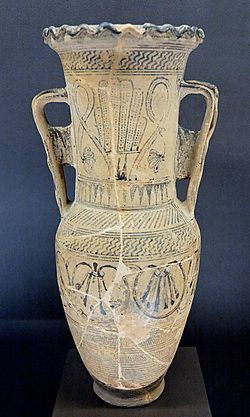
Loutrophoros
difference between proto geometric athenian and early geometric?
The difference lies in the decoration and motifs; Proto-Geometric pottery features simple shapes and few decorations, while Early Geometric pottery showcases more complex patterns and a greater variety of designs. LOL BUT WHAT??
Middle Geometric Period I (850 -
800 BC),
exclusively geometric ornamentation.
Middle Geometric Period II (800-
760 BC)
emergence of human
figures in vase decoration.
Sometimes scenes with a clear
narrative development.
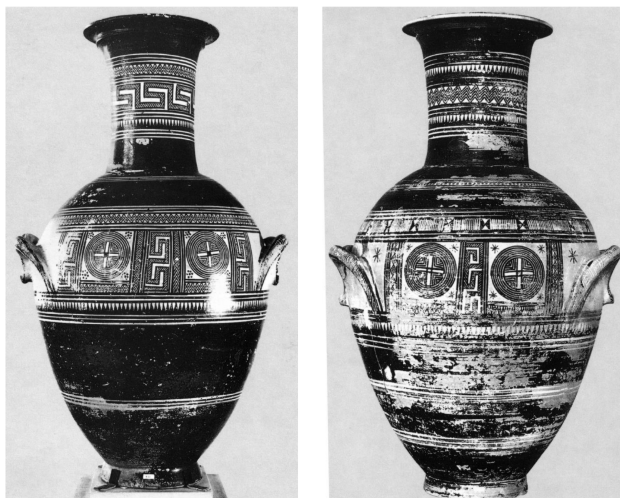
ATHENIAN MIDDLE-GEOMETRIC BELLY-
HANDLED AMPHORAE, 850–760 BCE .
Markers of Female Graves in the Kerameikos. — what makes this middle period where are the people? OH NVM NOT YET PEOPLE
THE EARLIEST FIGURATIVE SCENES
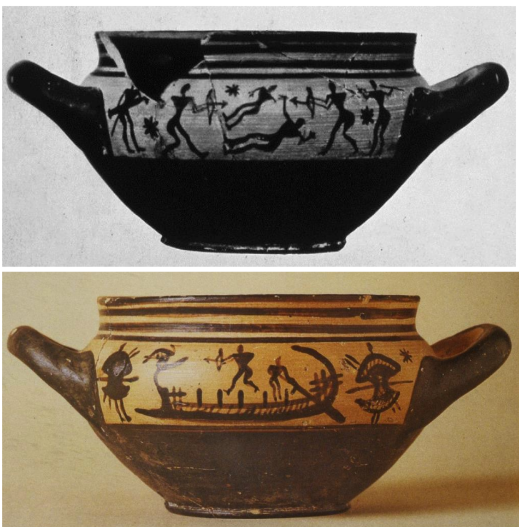
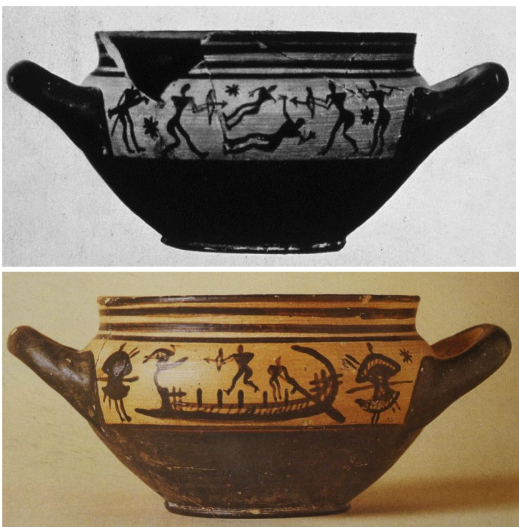
ca. 800-770 BC.
Middle-Geometric skyphos
from Eeleusis
LATE GEOMETRIC PERIOD
760/750 - 700 BC
Increase in population and in wealth (importation of
foreign luxury goods in Athens).
- Geometric decoration cover the entire surface of the vase
- Figurative scenes become more numerous (funerary
episodes; narrative scenes inspired by the heroes of
the Iliad and Odyssey (?)).

Belly-handel amphora, attributed to the
DIPYLON Master,, 760 BC circa
Athens, National Museum
Dipylon master
ancient Greek vase painter who was active from around 760–750 BC. He worked in Athens, where he and his workshop produced large funerary vessels for those interred in the Dipylon Gate cemetery, whence his name comes. His work belongs to the very late stage of the Geometric Style.
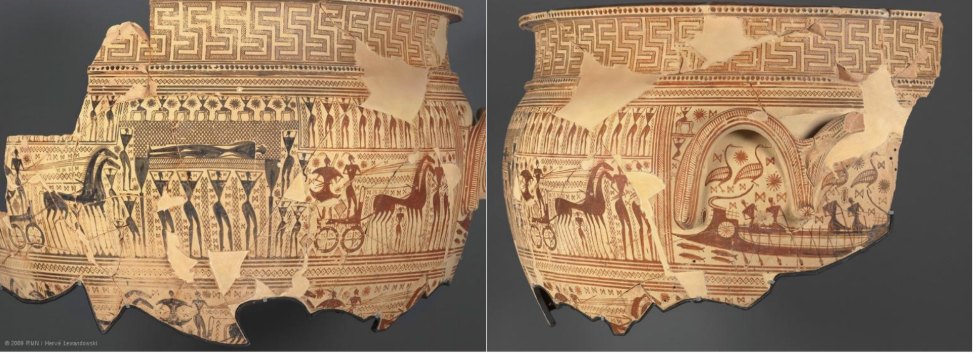
. LG KRATER, DIPYLON MASTER. Prothesis and Chariot Procession. Paris, Louvre, A 517.

ATHENIAN LG IbKRATER, New York. 750 BC.
HIRSCHFELD PAINTER.
Ekphora.
HIRSCHFELD PAINTER
è il nome convenzionale assegnato ad un vasaio e ceramografo attivo in Attica. — La sua produzione rientra nello stile del Tardo geometrico I e il suo nome si deve all'archeologo Gustav Hirschfeld che per primo nel 1872 ne ha descritto l'opera principale ad esso attribuita, il Cratere del Museo archeologico nazionale di Atene NM 990. — picks up from Dipylon master
PROTOGEOMETRIC AND
GEOMETRIC SCULPTURE
•Small-Scale Sculpture
•Function:
• Votive offerings (sanctuaries)
• Funerary contexts

this is the stuff from the geometric and protogeometric period — also lots of metal work that looks like sardinian art
Two distinct architectural approaches during this period (proto geometric)
• one in the Doric area of mainland Greece
• the other in the Ionic area of eastern Greece.
there is specific architecture from geometric period that you should add
THE ORIENTALISING PERIOD: VII CENTURY BC
The importation of Eastern goods and commercial interactions with Cyprus, Cilicia, Syria, and Phoenicia
were already well established by the early 9th century BCE. However, these exchanges intensified
significantly between the late 8th century and the early 7th century BCE, marking a period of increasing
contact and trade with Eastern cultures.
• Foreign products reached Greece through Eastern merchants and Greek traders, with key trading hubs such
as Al Mina (Orontes Valley) and Naucratis (Nile Delta) playing a crucial role.
• Growing prestige of major Greek sanctuaries (such as Olympia, Delphi, Delos): they attracted offerings
from Eastern rulers
• The Assyrian expansion prompted migrations, leading to an influx of Eastern artisans into Greece,
contributing to cultural and artistic exchanges
Three major phenomena shaped Greek cities between the late 8th and the entire 7th century BCE:
1. The emergence of lawgivers (Lycurgus in Sparta, Draco in Athens, Zaleucus in Locri, and Pittacus in Mytilene )
2. The rise of tyranny (eg. n Corinth, Sicyon, Megara, Miletus, Ephesus, and Mytilene)
3. The intensification of colonization
CERAMIC PRODUCTION IN THE
7TH CENTURY BC
Various centers of production,
including Athens, Corinth, Cyclades,
Ionia, Aeolia, and the Greek colonies
of Magna Graecia and Sicily.

Migrant Painters: The Chessboard Painter (680 BC circa: a
Protoattic Painter migrated from Athens to Metaponto (Italy).
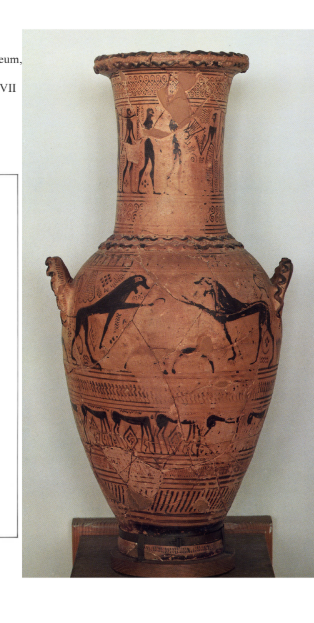
Athens, National Archaeological Museum,
Protoattic hydria by the Analatos
Painter (late VIII- Beginning of the VII
century BC)
Function: funerary. Three-handled water-pot with elongated neck. The 'snakes' and
fretwork handles indicate it was not made for daily use.
Technique: silhouette and outline
Style: Protoattic (Early). Date: early 7th c.
Decoration: male and female mourners (neck), lions confronting a floral (body)
Analysis: curvilinear floral motifs and lions (largely effaced) are indicators of a new
'Orientalising' style in Athens, whereas the largely silhouette figures (neck) combine the
old Geometric silhouette with outline.

PROTOATTIC Black & White Style. Neck-Amphora from
Eleusis. 680/670 BC. (middle protoAttic)
Secondary use as Container for Burial of a Child (enchytrismos) — what myth is this ?? who slays the giant? said Odysseus online

Bronze cauldron and stand from
Salamis, Cyprus. ca. 8th–7th century
B.C. Cyprus Museum, Nicosia. —little medusa vase pot thing (gorgons?) is that what they are called??
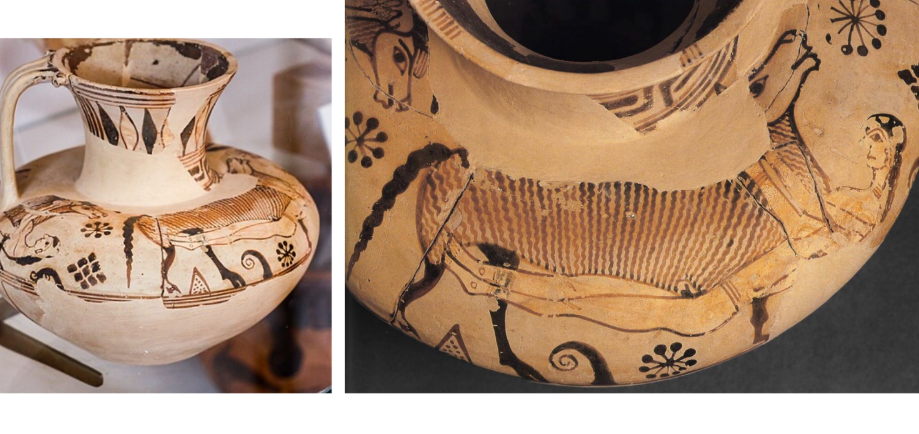
PROTOATTIC OINOCHOE, Berlin, Antikensammlung, Ram Jug Painter.
From Aegina. 650–640 BC — not sure what myth need to check?? Odysseus and ram or ox???
PROTO-CORINTHIAN POTTERY
• Early Proto-Corinthian (720–690 BCE)
• Middle Proto-Corinthian (690–650 BCE)
• Late Proto-Corinthian (650–630 BCE)
new shapes of pottery protocorinthian

Early Proto-Corinthian (720–690 BC)
No narrative focus, more decorative
No clear compositional order
Silhouette and outline technique
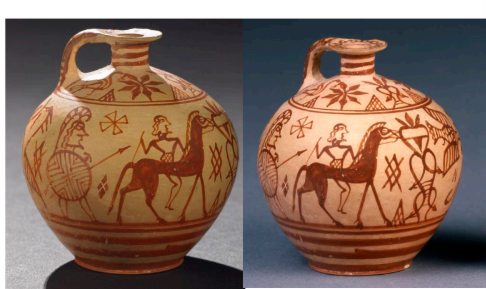
Protocorinthian aryballos attributed to the Evelyn Painter, c. 720–700 bc. (6.8
cm). London, British Museum, 1969,1215.1. Rider and warrior; lion and stag
evelyn painter
Protocorinthian vase-painter whose name is unknown. Nevertheless consistent individual characteristics of style suggest the existence of a unique artistic personality. He is called the Evelyn Painter, having been named after the former owner (W J Evelyn) of an aryballos subsequently acquired by the British Museum. He decorated the aryballos with animals, human figures and birds drawn in outline amid floral and other ornaments with a few touches of incision.
Middle Proto-Corinthian Period (690–650 BC)
• Figures more clearly defined
• Explicit reference to mythological themes
• Figurative elements meticulously arranged within miniature friezes
• Black figure technique
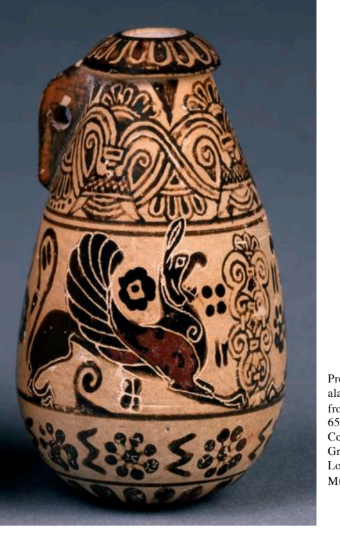
Protocorinthian
alabastron
from Kamiros, 660–
650 bce (Middle
Corinthian period).
Griffins. 5.8 cm.
London, British
Museum 1860,0201.30.
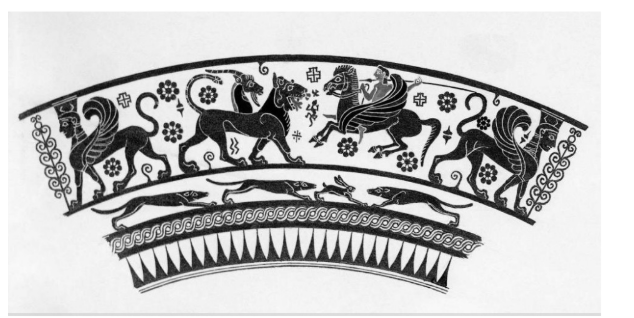
Alabaston, Middle Protocorinthian
about 650 B.C., Chigi Group. Boston MFA
Late Proto-Corinthian (650-630 BC)

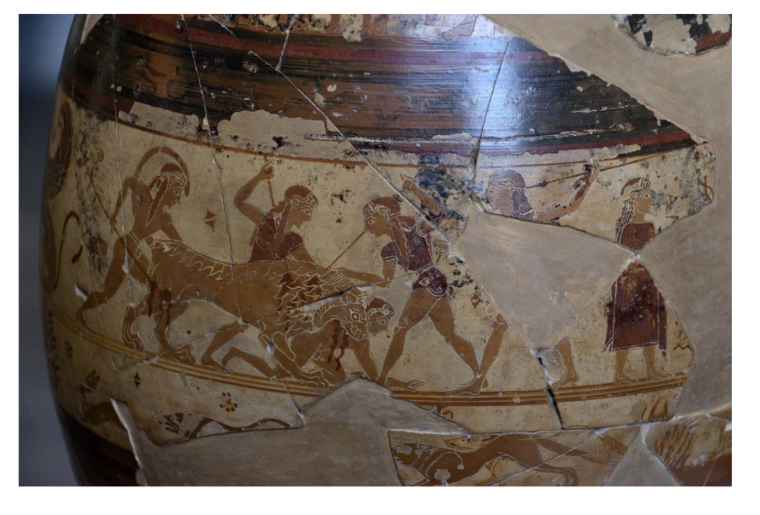
hunting scene late proto Corinthian
Chigi Painter
To create the detailed images in these registers, the artist who painted the Chigi Vase used a decorative technique known as black-figure. He first painted the figures in silhouette, filling them in as solid shapes against the lighter background of the clay. He then added details to the figures by scratching into them (and the surface of the vase) with a thin, sharp tool, creating incised lines.
Smarthistory – The Chigi Painter, The Chigi Vase
SCULPTURE DURING THE ORIENTALISING PERIOD
•A more defined sense of volume compared to the flat
votive figurines of the Geometric period
•Solid, three-dimensional forms that extend into space
•A strong axial structure with symmetrically added volumes
on both sides
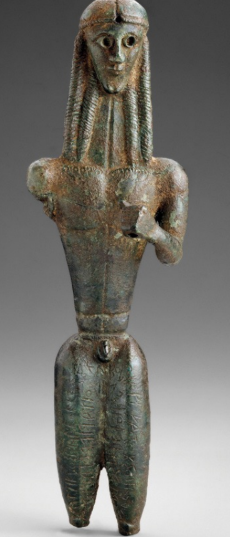
Nude male (Apollo?) dedicated by Mantiklos,
early 7th cent. bce. 20, 3 cm. Boston, Museum of Fine Arts 03.997.
Inscription on the legs: «Mantiklos dedicated (anetheke) me as a tithe (dekatos) to Apollo of
the silver bow; do you, Phoibos, give some pleasing favor in return».
Daedalus:
Daedalus: The archetype of the artist, a prototype of creativity and craftsmanship
VII century BC:
Emergence of monumental sculpture
• emergence of artistic personalities: First artist signatures ( eg. Euthykaridas
dedicated to Apollo at Delos a statue of a young man, explicitly stating that
it was made by him)
DAEDALIC SCULPTURE
Typical elements of the Daedalic style:
frontality, composition based on geometric
volumes arranged around a central axis, wig-
like hairstyle, triangular face
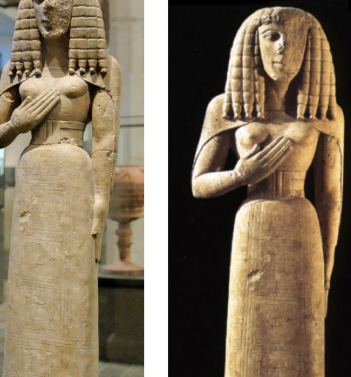
Auxerre Lady. Paris, Louvre. Shortly
after 650 BC (probably 640-30 BC.
Likely Cretan workmanship. Limestone.
Height 75 cm (with base).
daedalic kore went
crazy! (if you dont remember what this is means u gotta study)
Egyptian influence on Greek Orientalising sculpture
(large, colossal free-
standing sculptures) (especially visible in the production of Cycladic Islands):
• Greek merchants and mercenaries in Egypt (direct vision of colossal sculptures)
• Egyptian objects dedicated in Greek sanctuaries
Egyptian influence is in particular visible
in the type of the "KOUROS" (naked
male figure with an upright stance, arms
straight or slightly bent at the sides, fists
clenched, and one leg—usually the left—
slightly advanced forward).
KOUROI
(from middle of the VII th cent. BC)
Frontal position
• Nudity
• Solid and compact structure, organized around a central axis
• The slight advancement of the left leg allows the figure to stand freely in
space, moving away from the rigid frontal pose characteristic of earlier
geometric bronzes. However, this is not a representation of actual
movement; it is just a suggestion of movement.
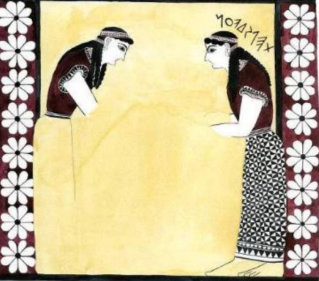
Chelidon and Aedon (Procne and Philomela) with the body of Itys (not visible). — I think part of the herion (you need to make a card on this) but has that one crazy myth fr
THE ARCHAIC PERIOD
(VI century BC)
Rising Influence and Prestige of Artisan Classes
Evolution of Trade and Craftsmanship
•Rapid and dynamic expansion of craftsmanship
•Expanding trade networks providing a stable market for goods
•Athens leading in ceramic production, while Corinth and Sparta dominate large-scale bronze work
6th Century Athens: Between Lawmakers and Tyrants
• Solon (archonship 594 or 591 BCE).
• Peisistratus (534- 528 BC)
• Athens expanded its influence in the Saronic Gulf, in Thrace, and in Euboea,
and it strengthened its influence over the sanctuary of Delos.
• Hippias (528-511/510 BC)
• Intense political debate (Cleisthenes VS Isagoras )
• Cleisthenes
6th Century Sparta: hegemonic influence in the Peloponnese
• Peloponnesian League
• significant economic vitality until mid VI century BC